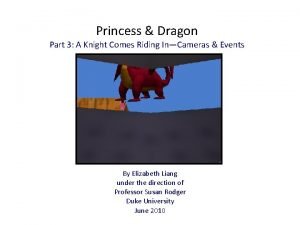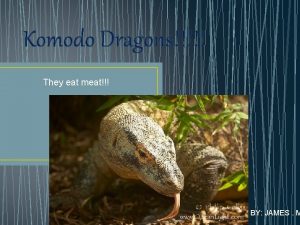Komodo Dragon Ethogram Shannon Weatherley Natural Science ClassificationDescription

- Slides: 1

Komodo Dragon: Ethogram Shannon Weatherley Natural Science Classification/Description • Varanus komodoensis, Komodo dragon is a lizard belonging to family Varanidae. • Largest living lizard with strong muscular tail, sharp claws, muscular short legs, a forked tongue, and a Jacobson’s organ. • Jacobson’s organ allows them to track down prey by picking up particles in the air using their tongue and rubbing it on the Jacobson’s organ to “smell” their prey. Habitat/Distribution • Commonly found on islands of eastern Indonesia, specifically Komodo and Flores where they are primary predator. • Live mostly in the tropical savanna forests but can roam throughout the islands. • Their range is smallest of world’s large carnivores. • Their main predator is humans other than other Komodo dragons. Social Structure • Large Komodo dragons cannibalize younger Komodo dragons, this would limit close encounters between Komodos. • Young Komodos will try to deter adults from cannibalizing them by rolling in the fecal matter of larger dragons. • The fecal material acts as a cover so the young dragons would have the scent of an older dragon. • While adults tend to be solitary, there is power in numbers for the young; the young participate in a ritual of appeasement. • The small dragons will pace around the feeding circle with a distinct walk, posture, and exaggerated movement. Reproduction • The mating season is around May to August. • Females will leave a trail of scent through their feces that will allow the males to track down a female • Males will compete is an aggressive violent ritual combat, they will be upright and wrestling each other: winner may copulate, and the loser may die. • Gravid females lay approximately 24 eggs most likely in an abandoned megapode (a large bird) nest. • The incubation period is long, around 180 days • Females can reproduce parthenogenically, meaning without copulating with a male, this happened in zoos. Feeding • Komodo dragons are carnivores and eat things as big as water buffalo, pigs, and deer. • Komodo dragons Often cannibalize young Komodo dragons. • The Komodo dragons also use their Jacobson’s organ to track their prey by picking up particles and “smelling” where their prey is. • They also can eat nearly 80% of their body weight in a meal as adults. • Small dragons eat smaller prey, such as smaller mammals, insects, other lizards, geckos, and eggs. • Komodo dragons drink water by taking a mouthful and then tilting their heads up allowing the water to flow down their throat. • Komodo dragons are venomous, their teeth are serrated to cause maximum damage and to compound that the venom has anticoagulant properties that allow the prey item to bleed out, decrease blood pressure and go into shock if it can get away. • The main strategy is to optimize their energy cost and gain by using a stealth method to hunt, they will prefer to wait for prey to conserve energy. METHODS/EXHIBIT DESCRIPTION RESULTS Exhibit description: 60. 0 • Kadal is solitary in his exhibit he is around 5 years old and was transferred here from Cameron Park, Waco, Texas. He is around 2 meters long. • The exhibit is large; glass window is around 4 meters long by around 2. 5 meters high. The ceiling is much higher than where the décor and exhibit details go. • There is lots concrete rock work for the exhibit, the walls up around 2. 5 meters tall, then the wall is painted blue up from there. • There is a little stream that flows into a pool, also there is a mister that is on very often if not all the time. There are branches and sticks with foliage on them that are put in there towards the back of the exhibit, around the mud/dig pit in the back towards the left. • The door to his exhibit is behind a sort of wall the way to the right corner below the mister/humidifier. • The door is hidden when walking up to the exhibit unless you are on the left side of the exhibit. • The lighting comes from above the window wall, Kadal lays right in the middle of the exhibit when resting and sunbathing where there is a rock/log. (Refer to the image under results to the right) 50. 0 Question and Method: • I am estimating how a captive Komodo dragons spends its time. This activity budget could be used to compare with those in a wild population or at another zoo. • The sampling method used for this project is all occurrences method of some behaviors (see Table 1) primarily accounting for the times that he moves and is active. • My main goal is to account for the behaviors in which Kadal is active versus when he is not moving/resting. • The results will be the percent of behavior resting verses the percent of behaviors that are considered active (Table 1). Data was recorded on an Excel Sheet, using 10 -minute intervals to split up behaviors over a 2. 5 -hour period. • The data was then analyzed for the percent of behavior that was resting out of all observed, then the percent that was active out of all behaviors observed. % of occurance BACKGROUND 50. 6 40. 0 30. 0 16. 9 20. 0 19. 3 9. 6 10. 0 2. 4 1. 2 0. 0 Resting (R) Stretching (ST) Alert (AL) Walking (WK) Scratching /Rubbing (SR) Other (OT) 0. 0 Not Visible Activities Figure 1: Percent occurrence of various behaviors, including: resting, stretching, alert, walking, scratching/rubbing, other, and not visible in Komodo dragon at Buffalo Zoo. Observations were made over 2 hours and 30 minutes, and the number of occurrences where there was a change from resting was noted. The most common behavior was resting about 50. 6% of the time, and the second most performed behavior was being alert about 19. 3% of the time (Fig. 1). The animal was visible the whole time. Collectively, activities that required any motion comprised 39. 4% (stretch, walk, scratch) (Fig. 1). The activities correspond with the activities in Table 1. Description of behaviors common for Komodo Dragons. Behavior Definition Resting lying down on its stomach, head lowered to the ground, eyes may (R) be open or closed. Stretchin Komodo may still be laying down, but he will stretch his legs and g (ST) move his tail Alert (AL) Komodo is stationary, lying down, sitting, or standing. The head is elevated, and eyes are open. Walking (WK) Komodo is moving using all four limbs. This is including walking, running, and climbing. Scratchin g/Rubbin g (SR) Other (OT) Komodo is scratching or rubbing his head against a surface or his front legs. This is a minor movement. Any other behavior not previously described. Include a description of any “other” behaviors you observe on the data sheet. CONCLUSIONS • It can be concluded that: • Kadal prefers to spend most of his time in the afternoon resting. • He often did minor behaviors that were less energy costing, as well as being alert to his surroundings. • He did walk for around 3 -6 minutes; this was the most energy costly activity that was observed over the 2. 5 hours. • It would have been more interesting to see how this were to play out over more than one occurrence of observing Kadal. BIBLIOGRAPHY Barry, C. “Komodo Dragons Kill With Venom, Researchers Find. ” May 3, 2018. https: //www. nationalgeographic. com/news/2009/5/komodo-dragon-venom/#close Bryner, J. “Female Komodo Dragon Has Virgin Births. ” December 20, 2006. https: //www. livescience. com/9460 female-komodo-dragon-virgin-births. html “Distribution. ” Komodo Survival Program, 2015. http: //komododragon. org/maps Jessop, T. S, Sumner. J, Rudiharto. H, Purwandana. D, Imansyah. M J, and Phillips. J. A. 2004. “Distribution, Use and Selection of Nest Type by Komodo Dragons. ” Biological Conservation 117 (5): 463– 70. https: //doi. org/10. 1016/j. biocon. 2003. 08. 005. “Komodo Dragon. ” Sea. World Parks & Entertainment. Accessed March 5, 2020. https: //seaworld. org/animals/facts/reptiles/komodo-dragon/. “Komodo Dragon. ” Smithsonian's National Zoo, October 3, 2019. https: //nationalzoo. si. edu/animals/komodo-dragon. “Life History. ” Komodo Survival Program, 2015. http: //komododragon. org/post/detail/2 “Komodo Dragon” https: //www. nationalgeographic. com/animals/reptiles/k/komodo-dragon/ “Komodo Dragon” https: //animalcorner. org/animals/komodo-dragon/ Photos: Taken By i. Phone at Buffalo Zoo, By : Shannon Weatherley

